
Myrtaceae, the myrtle family, is a family of dicotyledonous plants placed within the order Myrtales. Myrtle, pōhutukawa, bay rum tree, clove, guava, acca (feijoa), allspice, and eucalyptus are some notable members of this group. All species are woody, contain essential oils, and have flower parts in multiples of four or five. The leaves are evergreen, alternate to mostly opposite, simple, and usually entire. The flowers have a base number of five petals, though in several genera, the petals are minute or absent. The stamens are usually very conspicuous, brightly coloured, and numerous.

Knightia is a small genus of the family Proteaceae endemic to New Zealand, named in honor of Thomas Andrew Knight. One extant species, K. excelsa (rewarewa) is found in New Zealand. Two further Knightia species are found in New Caledonia, although they were placed in the genus Eucarpha by Lawrie Johnson and Barbara Briggs in their influential 1975 monograph "On the Proteaceae: the evolution and classification of a southern family", a placement supported in a 2006 classification of the Proteaceae. A fossil species from upper Miocene deposits in Kaikorai has been described as Knightia oblonga. Knightia has been placed in the tribe Roupaleae of the subfamily Grevilleoideae.
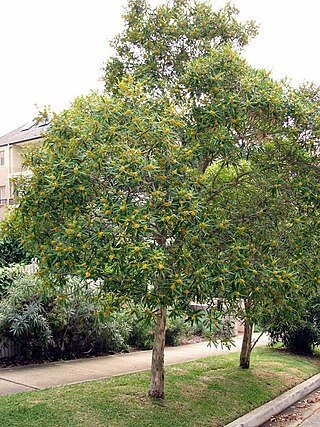
Tristaniopsis is a group of shrub and tree in the myrtle family Myrtaceae described as a genus in 1863. They have a wide distribution in Southeast Asia, New Guinea, New Caledonia and Australia.
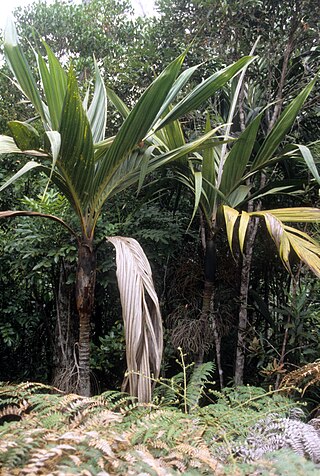
Basselinia is a genus of flowering plant in the family Arecaceae. The entire genus is endemic to the Island of New Caledonia in the Pacific. In some molecular phylogenetic analyses, Hedyscepe from Lord Howe Island is nested in Basselinia.
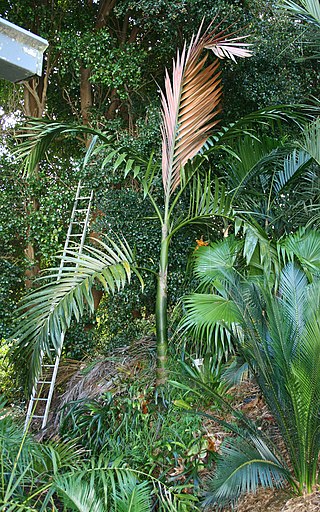
Chambeyronia is a genus of flowering plants in the family Arecaceae. It contains nine species, all endemic to New Caledonia:

Cyphophoenix is a genus of flowering plant in the family Arecaceae. It contains 4 known species, all endemic to New Caledonia. The relationships between Cyphophoenix and some other genera of the tribe Basseliniinae including Physokentia and the New Caledonia endemic Burretiokentia are not clear.
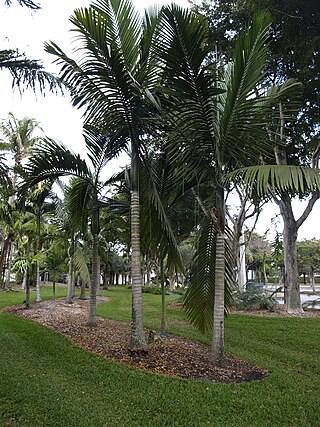
Kentiopsis is a genus of palm trees endemic to New Caledonia. Relationships between Kentiopsis and the other genera of subtribe Archontophoenicinae, including the Australian Archontophoenix and the New Caledonia endemic Chambeyronia and Actinokentia are unresolved.

Beauprea is a genus of flowering plants in the family Proteaceae. Its 13 extant species are endemic to New Caledonia, though closely related forms have been found in the fossil records of Australia and New Zealand. Its closest extant relatives are the African Protea and Faurea.

Blepharocalyx is a genus of plant in family Myrtaceae first described as a genus in 1854. It is native to South America and the West Indies.
- Blepharocalyx cruckshanksii(Hook. & Arn.) Nied. - Chile
- Blepharocalyx eggersii(Kiaerskou) L.R.Landrum - Lesser Antilles, Venezuela, Guyana, Peru, Brazil
- Blepharocalyx myriophyllus Mattos - Minas Gerais
- Blepharocalyx salicifolius(Kunth.) O.Berg - Brazil, Bolivia, Peru, Ecuador, Paraguay, Uruguay, N Argentina

Soulamea is a genus of plant in family Simaroubaceae. They are shrubs or small trees, and are dioecious, with the exception of Soulamea amara, which has bisexual flowers. It is native to parts of Malesia in the West Pacific. From the Seychelles, Borneo, Bismarck Archipelago, Caroline Islands, Marshall Islands, New Caledonia, New Guinea and Maluku to the Solomon Islands and Vanuatu.

Xanthostemon is a genus of plants in the myrtle family Myrtaceae, first described in 1857 by the German–born Australian botanist Ferdinand von Mueller. The genus is distributed across Malesia, Papuasia and northern Australia. The genera Pleurocalyptus and Purpureostemon from New Caledonia are morphologically close to Xanthostemon.
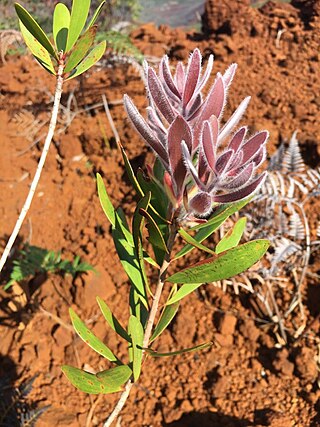
Melaleuca pancheri is a shrub or small tree in the myrtle family, Myrtaceae and is endemic to the south of Grande Terre, the main island of New Caledonia. It is one of only a few members of its genus to occur outside Australia and was formerly known as Callistemon pancheri Brongn. & Gris.

Joinvillea is a flowering plants genus in the family Joinvilleaceae. The family consists of one genus with species distributed from the Malay Peninsula to the Caroline Islands and high islands in the Pacific Ocean. It is evolutionarily significant as a relictual group that is a close relative of grasses. They closely resemble large grass plants, in both general appearance and microanatomy, but possess fleshy fruits.
Eucarpha is a genus of flowering plant of the family Proteaceae, endemic to New Caledonia. Two species are recognised. Up to 1975, these were classified within the genus Knightia until Lawrence Johnson and Barbara G. Briggs recognised their distinctness, particularly their prominent bracts, in their 1975 monograph "On the Proteaceae: the evolution and classification of a southern family". Nomenclatural combinations for these two species in the genus Eucarpha were published in 2022.
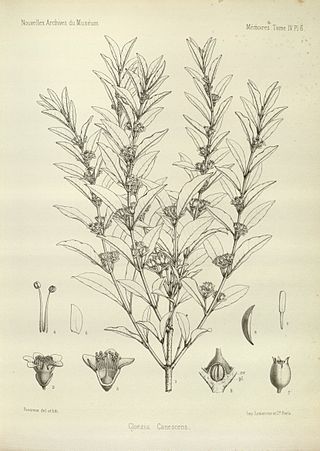
Cloezia is a genus of flowering plants in the family Myrtaceae first described as a genus in 1863. The entire genus is endemic to New Caledonia. It is related to Thaleropia, Tristania and Xanthomyrtus.
Purpureostemon is a genus of plant in the myrtle family Myrtaceae described as a genus in 1939. There is only one known species, Purpureostemon ciliatus, endemic to New Caledonia. Purpureostemon is related to Xanthostemon.
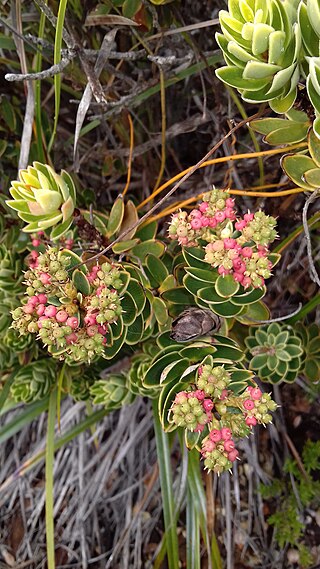
Cyathopsis is a genus of shrubs in the family Ericaceae. The genus is endemic to New Caledonia in the Pacific and contains three species that have previously been included in Styphelia. It is related to genera such as Leucopogon, Lissanthe and Styphelia.
Syzygium elegans is a shrub belonging to the Myrtaceae family. It is found on the island of New Caledonia and grows to a height of 1 to 2 m. Syzygium elegans is found on or beside creeks and streams. Leaves are linear or oblanceolate, 2.5 to 4 cm long and about 0.3 to 0.6 cm in width. Flowers are white, they have 4 sepals and 4 petals. Which is then followed by a white or red fruit, which contains one seed.
Eucarpha deplanchei is a species of flowering plant in the family Proteaceae, native to New Caledonia. It was first described in 1865 as Knightia deplanchei.















